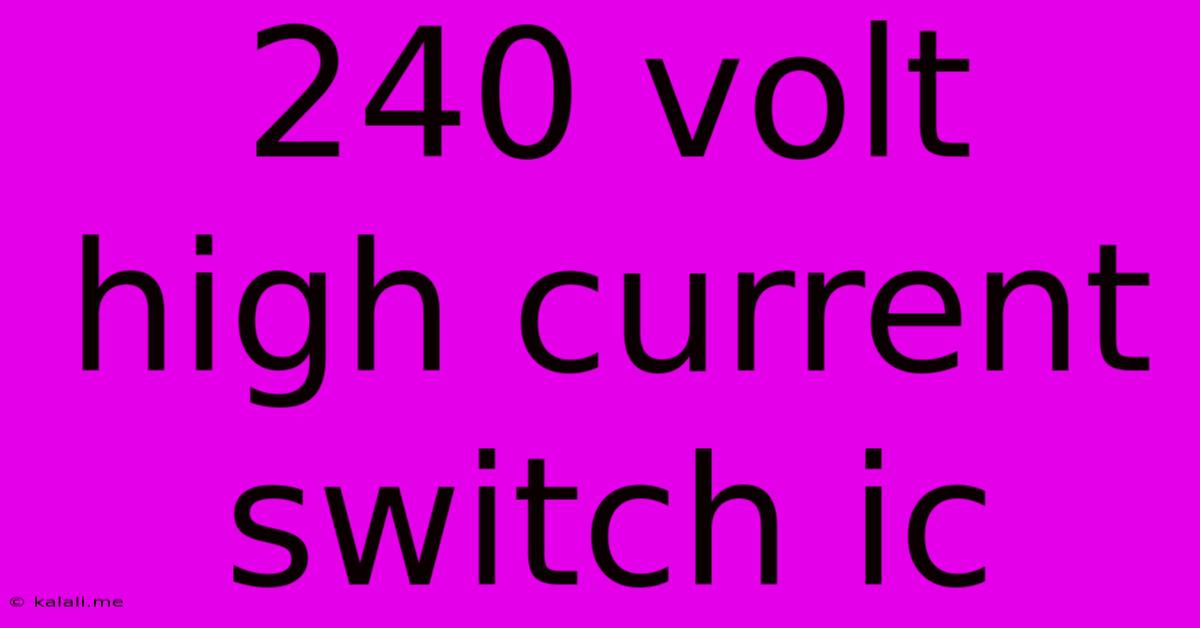240 Volt High Current Switch Ic
Kalali
May 24, 2025 · 3 min read

Table of Contents
240 Volt High Current Switch IC: A Deep Dive into High-Power Semiconductor Solutions
Meta Description: This article explores the world of 240-volt high-current switch ICs, examining their applications, key features, selection criteria, and the importance of safety considerations in high-power switching circuits. Learn about different technologies and how to choose the right IC for your project.
High-power switching applications requiring the control of significant current at 240 volts present unique challenges. These applications demand specialized integrated circuits (ICs) capable of handling high voltages and currents while maintaining efficiency and reliability. This article delves into the intricacies of 240-volt high-current switch ICs, providing a comprehensive overview for engineers and hobbyists alike.
Understanding the Need for Specialized ICs
Traditional transistors and relays struggle to handle the combination of high voltage and high current efficiently and reliably at 240V. They often suffer from high switching losses, leading to heat generation and reduced lifespan. This is where specialized high-current switch ICs step in. These integrated circuits are designed to overcome these limitations, offering several key advantages:
- Improved Efficiency: Optimized internal circuitry minimizes power dissipation, resulting in higher efficiency and less heat generation.
- Enhanced Reliability: Robust designs and protection mechanisms enhance the reliability and longevity of the switch.
- Compact Size: Integration onto a single chip reduces the overall size and complexity of the circuit.
- Precise Control: These ICs typically offer features enabling precise control over switching speed and timing.
Key Features and Specifications to Consider
When selecting a 240-volt high-current switch IC, several key parameters must be considered:
- Voltage Rating (V<sub>DSS</sub> or V<sub>CE</sub>): This specifies the maximum voltage the IC can withstand. For 240V applications, a significant safety margin is crucial.
- Current Rating (I<sub>D</sub> or I<sub>C</sub>): This indicates the maximum continuous current the IC can handle. Choose an IC with a rating exceeding your application's peak current demands.
- Switching Speed: The switching frequency affects efficiency and the generation of electromagnetic interference (EMI). Faster switching speeds can improve efficiency but might increase EMI.
- On-Resistance (R<sub>DS(on)</sub> or R<sub>CE(sat)</sub>): Lower on-resistance leads to reduced power loss during the on-state.
- Protection Features: Look for ICs with built-in protection features such as overcurrent protection, overvoltage protection, and thermal shutdown. These features are essential for safe and reliable operation.
- Package Type: The choice of package will impact the ease of integration into your circuit board. Consider factors like thermal management and PCB space constraints.
Applications of 240 Volt High Current Switch ICs
These specialized ICs find applications in a wide range of high-power systems:
- Motor Control: Driving high-power AC motors in industrial machinery and robotics.
- Power Supplies: Switching regulators and power converters in high-voltage power supplies.
- Heating Systems: Controlling high-power heating elements in industrial and residential settings.
- Lighting Systems: Switching high-power lighting fixtures, particularly those using high-intensity discharge lamps.
- Industrial Automation: Various control systems in factories and manufacturing processes.
Safety Considerations
Working with high voltages and currents necessitates stringent safety precautions:
- Proper Insulation: Use appropriate insulation materials and techniques to prevent electrical shocks and short circuits.
- Fuse Protection: Incorporate fuses or circuit breakers to protect the IC and other components from overcurrent events.
- Heat Dissipation: Ensure adequate heat sinking to prevent overheating and potential damage to the IC.
- Grounding: Proper grounding is crucial to minimize the risk of electrical shocks and ensure safe operation.
Choosing the Right IC for Your Project
Selecting the appropriate 240-volt high-current switch IC requires a careful analysis of your application's specific needs. Consider the voltage and current requirements, switching speed, efficiency goals, and the necessary protection features. Always consult the IC's datasheet for detailed specifications and application guidelines. Thorough planning and careful component selection are critical for building safe and reliable high-power systems.
Latest Posts
Latest Posts
-
Ola Hallengren For Distribution Availability Group
May 24, 2025
-
Is It Dangerous If Circuit Breaker Keeps Tripping
May 24, 2025
-
How To Enable Find My Mac
May 24, 2025
-
Badges Swapped Accidentall Gen 1 Ug
May 24, 2025
-
And So They Were Both Bottoms
May 24, 2025
Related Post
Thank you for visiting our website which covers about 240 Volt High Current Switch Ic . We hope the information provided has been useful to you. Feel free to contact us if you have any questions or need further assistance. See you next time and don't miss to bookmark.